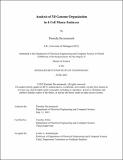Analysis of 3D Genome Organization in 4-Cell Mouse Embryos
Author(s)
Davarmanesh, Parmida
DownloadThesis PDF (6.130Mb)
Advisor
Uhler, Caroline
Terms of use
Metadata
Show full item recordAbstract
Cell fate determination, which refers to how distinct types of signals interact with a cell to determine its fate and differentiation into a particular cell type, is a fundamental questions lying at the heart of developmental biology. Given that the type and state of a cell is deter-mined by its gene expression program and recent work has shown a tight coupling between the spatial organization of the genome inside the cell nucleus and a cell’s gene expression profile, in order to gain insights into cell fate determination, we studied the 3D genome organization; in particular how chromosomes are arranged in the 3D space of the cell nucleus. More precisely, we studied the 3D genome organization in early mouse embryos at the 4-cell state based on in-situ sequencing data. Interestingly, while at this stage the cells have only undergone 2 divisions, researchers have found that the type of division (equatorial or meridional) matters for the chance of survival of the embryo at later stages. Using in-situ genome sequencing data, 1) we developed a constrained k-means algorithm that clusters the genomic loci into two clusters (corresponding to the paternal/maternal copies of each chromosome); 2) using parental origin information (available for a few genomic loci) we inferred the parental origin of the identified chromosomes; and 3) we built an alignment algorithm to assign an inter-cell distance between any two cells given their dissimilarity in terms of the 3D organization of the chromosomes in the cell nucleus. Using these inter-cell distances, we mapped all the cells in the data set into an embedding space; we found that not only the sister cells in the data set cluster together, but the majority of cousin cells (cells belonging to the same 4-cell embryo) also cluster together. Additionally, while the type of cell divisions (equatorial or meridional) in each embryo in our data set is unknown, we used the inferred 3D genome organization to make a hypothesis about the type of division and the resulting shape of the 4-cell embryo. Although additional experiments are needed to correlate embryo shape with 3D genome organization, our preliminary results may open novel avenues towards analyzing cell fate determination. All of the code for reproducing the analysis can be found here: https://github.com/pdavar/Analysis-of-3D-Mouse-Genome-Organization
Date issued
2023-06Department
Massachusetts Institute of Technology. Department of Electrical Engineering and Computer SciencePublisher
Massachusetts Institute of Technology